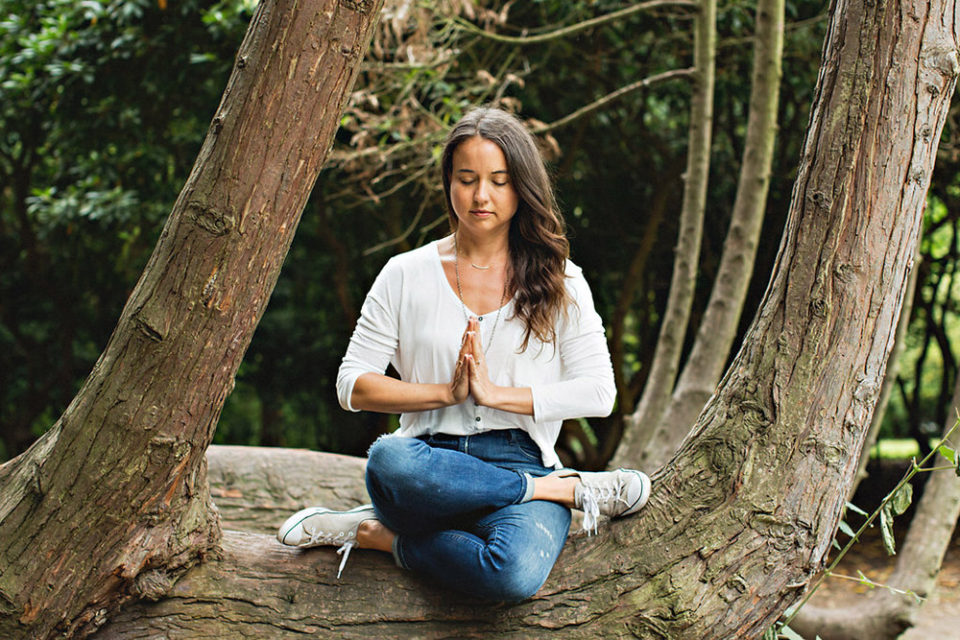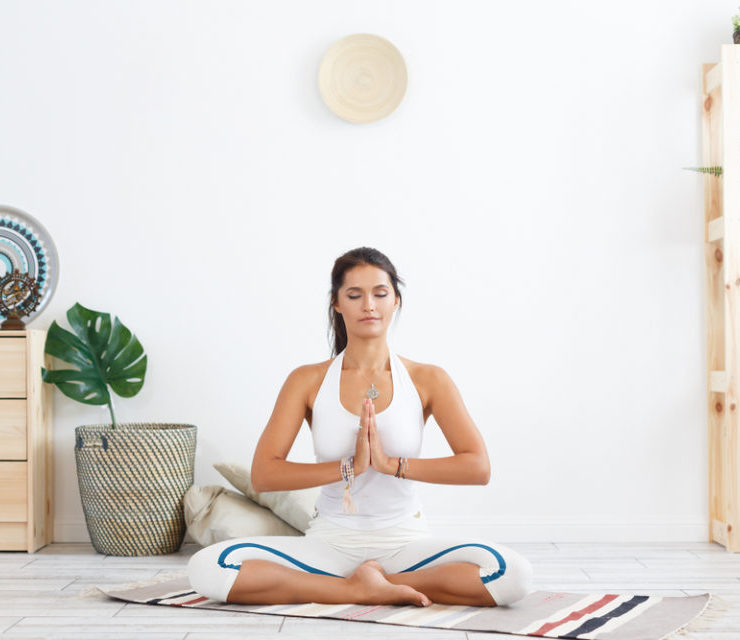Meditation. Just what the doctor ordered.

Almut Schotte is a Registered Yoga Teacher (RYT) with Yoga…
Have you always wanted to meditate but never seem to have time?
You know it would be good for you, but for some reason you haven’t started yet? The end of the year is the perfect opportunity to prepare for the year ahead by starting a meditation practice.
Nowadays, most of us are aware that meditation can improve many different aspects of our life: it strengthens our immune system, improves cardiovascular health, helps with stress, reduces anxiety and depression, and enhances cognitive function. Those are only a few of the benefits of meditation that we can see in recent research. But none of this helps unless we do it. As always, the beginning is the hardest part, so here are some ideas on how you can start to meditate and change your life by “doing nothing.” But first, let’s talk about some of the benefits of meditation.
“We can’t always reduce the stress in our lives but we can change our reaction to it.”
1. It reduces stress
We can’t always reduce the stress in our lives but we can change our reaction to it. Stress can have an extremely negative impact on our body and mind. Cortisol and adrenaline are the two main stress hormones in the body, and between the two of them, we see a widespread effect on many different organs and systems of the body. Meditation can be a key player in reducing and regulating the release of these stress hormones, which can have major health implications, ranging from its effects on heart health, to metabolism, to energy levels, and optimizing our digestive and immune systems. Meditation helps us handle stressful situations with ease.
2. It improves sleep
Getting a good night’s sleep can be trickier than it sounds. If you’ve ever struggled with insomnia, you know that part of the problem is dreading not being able to fall and stay asleep! There are many reasons why we are not able to fall asleep or why we wake up in the middle of the night. For some of us, it can be stress and mental rumination on tasks or unsolved problems that keep us awake at night and for others it could be low melatonin levels. Meditation can help regulate melatonin levels to help you fall asleep and stay asleep for a deep restful night of sleep.
3. It makes you smarter
Modern science has proven that we use only a fraction of our brain. Recent studies have shown that meditation boosts alpha brainwaves, which are responsible for learning, memorizing, and studying. Neuroscience has also proven that meditation and mindfulness training stimulate creative thinking while minimizing depressive symptoms and other mental conditions. When alpha oscillations are prominent, your sensory inputs tend to be minimized and your mind is generally more clear and focused – ready to be at your service.
What Is Meditation?
OBSERVE. PERCEIVE. BE MINDFUL. Nothing less and nothing more. Some people think of meditation as some kind of special activity, but it’s more about stopping and being present. In our daily lives, we run around doing, performing and achieving goals. With meditation, we want to create time to simply stop and notice. And as soon as you—there you are, about to meditate. You simply hear, smell, listen – you observe the present moment.
Let’s Get Started
You can meditate anytime and anywhere you want. It doesn’t need to be a special place and it does not need to be done for a long time. You can meditate for a couple of minutes or half an hour – either way, you will feel the effects.
Frequency is key – Find a slot in your daily life where you commit to a daily meditation routine. Keep in mind that frequency is more important than duration. Research has shown that it’s beneficial to do three minutes a day rather than 20 minutes once a week. You can always increase the time when you feel ready.
Find a time slot that works. Meditate at the same time each day, in the morning right after getting up, during your lunch break, or in the evening before heading to bed. Whatever time works for you the best, just commit to it and make it a daily habit.
Choose a quiet location. It doesn’t matter where you sit, as long as it’s quiet and nobody can disturb you. Mornings are often a good time, because everybody else is still sleeping. Or hang a sign “Meditation in Progress” for your family or roommates. Shut off your phone, close the door, and get started.
Set your timer. Even if you just sit for a couple of minutes, a timer is helpful so you don’t need to keep checking the clock.
Get comfy. Find a comfortable seated position on a cushion or on a chair. Sit upright, relax your neck muscles, and let your shoulders drop. Your hands can rest in your lap or on your knees.
Close your eyes if you can, or keep them open. Closed eyes will help you to focus without getting distracted, but slightly open eyes are fine. Just keep your eyes relaxed as you turn your awareness inwards.
Do nothing. Just observe. In the beginning, or on a busy day, the “do nothing” part is often the hardest. With your eyes closed, focus your senses on your breath. Be an observer and perceive how you inhale and ho exhale. If your mind starts to wander, simply notice and bring it back to observing your breath. When your mind starts to calm, welcome the stillness inside.
Keep in mind that “Every journey starts with the first step.” Why not start the new year with a new journey, one step at a time, without expectations or judgements, just committing to a daily meditation practice?
Here are 4 simple meditation techniques:
Here are 4 simple mediation techniques. Pick the one that works best for you:
1. Observe the breath
Place your attention on your breath and follow its path through the body. As it comes in through your nostrils, follow it all the way down to your lungs as you inhale. Observe the path from the lungs back through the nostrils on your exhale.
2. Count the breath
Bring your attention to your breath. Simply notice the breath as it moves in and out, as the body inhales and exhales. Count “one” as you take the first breath in, “two” as you exhale. Continue to the count of 10, then start again at one. If you lose your place or end up past 10 (which you will), just start back at 1 again.
3. Find stillness
Once you are settled into observing the breath, become aware of the point between your inhale and exhale. Notice this small gap between the breaths, this moment of stillness.
4. Release tension
With closed eyes, bring your attention to your body. Feel the contact with your body on the ground and allow your shoulders, neck, and back to soften. Be aware of your breath and feel how your body expands and contracts as you inhale and exhale. Guide your attention to an area where you feel tension. Allow the breath to soothe and massage this area. With each inhalation you create space in this area and with each exhalation you soften and let go of the tension. Stay here for a couple of breaths before moving on to the next area.
Close your meditation with a smile and a moment of gratitude for all that you have and that you have made this time today for yourself.
What's Your Reaction?
Almut Schotte is a Registered Yoga Teacher (RYT) with Yoga Alliance, which acknowledges the completion of a yoga teacher training with a Registered Yoga School (RYS).







